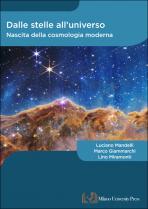Dalle stelle all'universo. Nascita della cosmologia moderna
Synopsis
The homo sapiens has always been fascinated by the spectacle of the starry sky, leading him to ask himself deep questions: what is above us? Is the Universe eternal or was it born, and how, in a remote time? Is it finite or infinite? What is its future? Are we alone or are there other planets, other worlds?
To answer to these questions, at least in part, and with the conviction that it is the duty of men of science to transmit to society the news of leading-edge knowledge, we have written this book. Here we tell, with simplicity but with rigor, how in the last century, discovery after discovery, the pattern of the Universe that men had conceived in the past has fallen apart and a different, fascinating and even disturbing picture has gradually emerged.
But this story is not just a story of intellect and reason; it is also a story of feelings. It is no accident that the authors of this book, experts in particle physics and astroparticle physics, have been seized by an authentic passion for these cosmological themes, for that extraordinary mystery that encloses the starry sky.
Downloads


This work is licensed under a Creative Commons Attribution-ShareAlike 4.0 International License.
